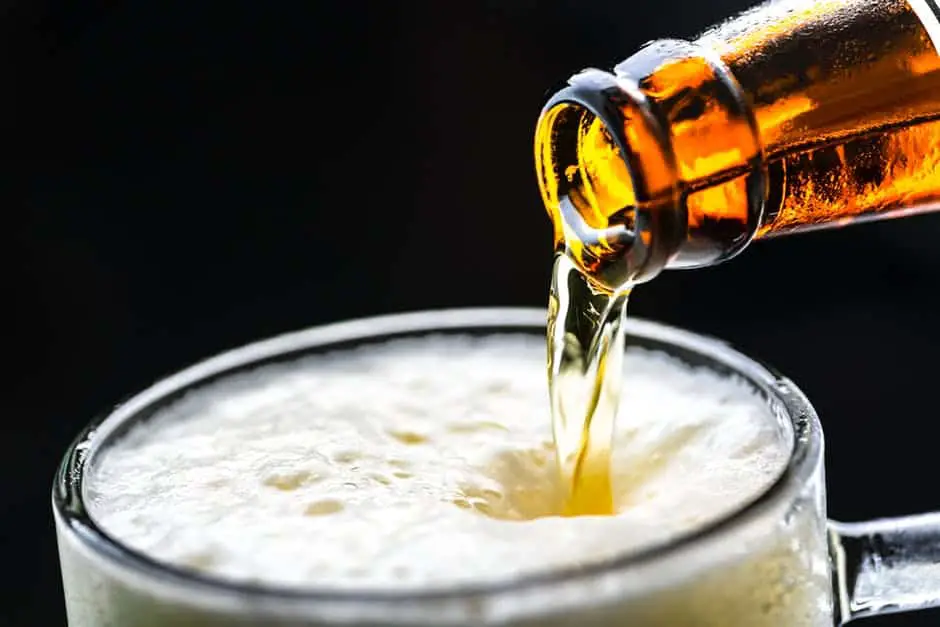Table of Contents
*This post may contain affiliate links. As an Amazon Associate we earn from qualifying purchases.
The more you understand about beer and the art of brewing, drinking, and enjoying beer, the more you can fully appreciate the delicious liquid nectar of the gods in all of its glory. Some would argue that the absolute most important aspect to know about beer is the ABV or alcohol by volume.
The ABV is usually listed as an abbreviation and can tell the beer drinker or beer buyer a lot about the beer, what it will taste like, and help distinguish what beers you enjoy or do not enjoy. Figuring out what ABV means and how the level relates to beer can help you better understand your own preference for beers and the beers behind the bar at your local watering holes.
LET US BREAKDOWN ABV
As stated above, the alcohol by volume is typically measured as a percentage and can be found on the bottle or can of the beer you are drinking. Law in the United States requires breweries to list the ABV listed on each individual beer. That way, customers can have an idea of how much alcohol is inside the beer they are drinking or buying.
The ABV percentage tells the drinker how much of the beer is alcohol and how much is the other ingredients, like water. To put it in layman’s terms, the higher the ABV, the higher the alcohol, the drunker the drinker. Beer alcohol content or ABV varies widely and is dependent on the type of beer, flavor of beer, and desired taste of the beer.

How Does Beer Become Alcohol
Alcohol is created through the fine art of fermentation. It is a byproduct of yeast that has metabolized grain-derived, fermentable sugars into alcohol and carbon dioxide gas. The final level of alcohol or ABV depends on what type of yeast was used, the amount of sugar the yeast digested, and the fermentation method used.
The malts are the first step in the intricate brewing process at any brewery. The malts are brought on a conveyer system from the silo to the brewhouse where modern technology softens and removes most, or all, of the intact barley husk before the kernel inside is ground up. A sweeter and less tannic wort is created when the amount of husk in the ground malt is limited.
The brewers then transfer the softened malt into the mash tun where it is mixed and the enzymes that transform the malt starches into simpler sugars become activated. The next step is the lauter tun, a machine that acts like a very large strainer to separate the sugar and nutrient-rich wort, which is the liquid that eventually becomes the final delicious product of beer.
The fresh wort is then transported to the brew kettles where the whole flower hops or processed hop pellets are added to each flavor to produce the different strain of beer desired in the specific brewery. The hops are removed after a certain amount of time and then a whirlpool is used to sift out any remaining particles before the hopped wort is sent to the beer cellar for fermentation.
After fermentation, brewers add specific yeast strains to each to create each flavor of beer. The yeast converts the simple sugars from the brewing process into alcohol and carbon dioxide gas. After each beer is fermented and matured to appropriate levels, most of the beers made at the brewery are sent through a filtration system to make sure all yeast particles are removed to prevent any spoilage.
The only beers not sent through the filtration are the unfiltered beers. The final step of the brewing process is bottling, kegging and/or canning the beers and having them sent to the quality assurance team.
Beer Alcohol Content

The standard measure of how much alcohol (ethanol) is contained in a given volume of an alcoholic beverage is defined as the number of milliliters of pure ethanol present in 100 mL of solution at 68 degrees Fahrenheit or 20 degrees Celsius. The number of mL of pure ethanol is the mass of the ethanol divided by its density at 20 degrees Celsius, which is 0.78924 g/mL.
ABV is a standard of alcohol measurement used worldwide and the International Organization of Legal Metrology has tables of density of water-ethanol levels found at different temperatures and concentrations. Another way that the levels of alcohol are measured when it comes to alcoholic beverages includes alcohol proof. This is another way to specify the amount of alcohol inside of a liquid, which in the United States is twice the alcohol-by-volume number.
The ABV can really affect how the flavor of a beer is perceived. If the beer is well balanced, you will not be able to taste the alcohol in it. The era of craft beer is upon us though, and there are some beers that climb the limits of high ABV levels. Session beers, for example, are called that because of their low alcohol content around 4.5% ABV.
IPAs and imperial stouts on the other hand usually have higher ABVs in the 6% range. The Craft Beer Styles Study Guide is for beer lovers who want to dive even deeper into the quantitative style statistics and more. The ranges in alcohol as far as beer tastes go include not detectable, mild, noticeable, and harsh.
A synonym for ethanol or ethyl alcohol is the colorless and primary alcohol component of beer. The ABV level ranges from as low as 2% in shandy style beers to greater than 14% in double-aged whiskey barrel stouts. Fused alcohol can also exist in beer and the ABV has a profound effect on the beer’s aroma, taste, flavor, and palette.
Styles of Beers and ABV
A lager typically ranges from 4% to 5% alcohol by volume and a pilsner is typically 3% to 6% ABV. Darker beers such as stouts and porters, including Guinness, range from 5% to 10% ABV for stouts and 4% to 5% ABV for porters. Brown ales include amber styles and range from 4% to 6% ABV. India Pale Ales are the last of the major styles of beer and can be found to range from 6% to 7% ABV.
We are going to unfold the alcohol by volume content of the most popular beers so that you can familiarize yourself with the basics of ABV. Pabst Blue Ribbon has a 2.2% ABV, while Miller Genuine Draft brewed by MillersCoors offers 2.8%. Bud Light features a 4.2% ABV and Miller Lite features a 4.2% ABV. Heineken’s ABV is 5.4% and Dogfish Head by Dogfish Brewery has an outstanding ABV of 15%.

Gaining knowledge and doing your research when it comes to the types of beer you like to drink and their alcohol by volume content is an invaluable tool to have in order to drink responsibly and intelligently. Knowing all this extra information about beer alcohol content is also a wonderful way to impress friends, beer drinkers, and woo potential lovers.
READ THE LABEL ANDLOVE THE BEER
Beer alcohol content is very important to take into consideration when it comes to the type of beer you purchase and consume. The most important thing you can do to ensure you know the ABV is to read the label of the beers you buy and drink. This amazingly helpful and informative list of 265 beers and their ABV efficiency levels is very awesome to learn more about beers. This list can help you decide which beers you already enjoy, beers you might enjoy, and other fun facts about beer alcohol content.

Bars, liquor stores, and places that you buy beer from are typically very informative and helpful when it comes to providing ABV information to the consumer. Apart from being printed on the beer’s label, ABV can also be inquired about with the local employees where you purchase your beer. A general rule is if the beer has an ABV above 7%, only 8 ounce pours of the beer should be drank. Other wise, beers with lower than 7% ABV are typically served in twelve ounce pours.

